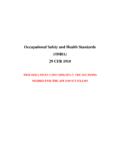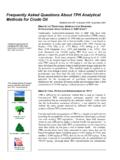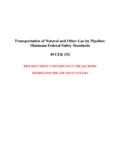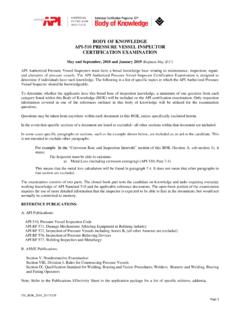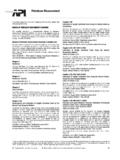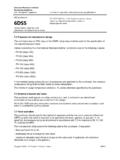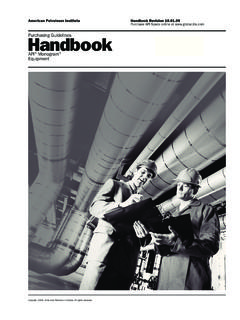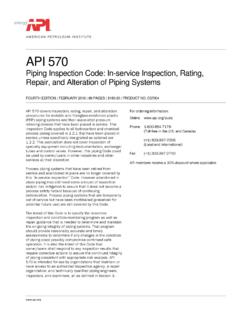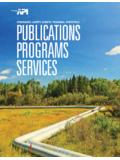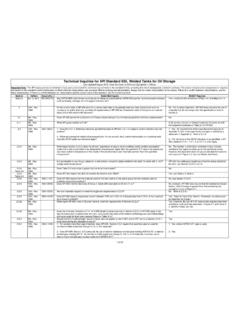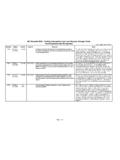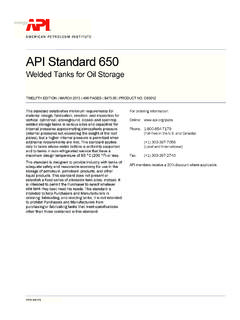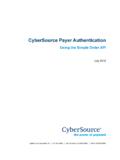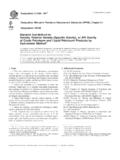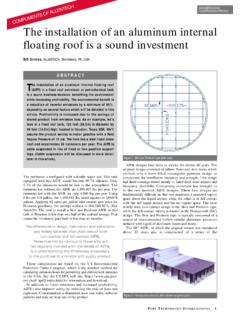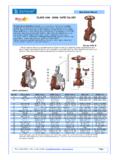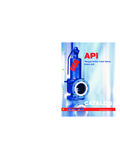Transcription of API Standard 653 - American Petroleum Institute
1 API Standard 653. Tank Inspection, Repair, Alteration, and Reconstruction FIFTH EDITION | NOVEMBER 2014 | 162 PAGES | $ | PRODUCT NO. C65305. This Standard covers steel storage tanks built to API 650 This Standard recognizes fitness-for-service assessment and its predecessor API 12C. It provides minimum concepts for evaluating in-service degradation of pressure requirements for maintaining the integrity of such tanks containing components. API 579-1/ASME FFS-1, Fitness-For- after they have been placed in service and addresses Service, provides detailed assessment procedures or inspection, repair, alteration, relocation, and acceptance criteria for specific types of degradation reconstruction. referenced in this Standard . When this Standard does not provide specific evaluation procedures or acceptance criteria The scope is limited to the tank foundation, bottom, shell, for a specific type of degradation or when this Standard structure, roof, attached appurtenances, and nozzles to explicitly allows the use of fitness-for-service criteria, API.
2 The face of the first flange, first threaded joint, or first 579-1/ASME FFS-1 may be used to evaluate the various welding-end connection. Many of the design, welding, types of degradation or test requirements addressed in this examination, and material requirements of API 650 can Standard . be applied in the maintenance inspection, rating, repair, and alteration of in-service tanks. In the case of apparent conflicts between the requirements of this Standard and API 650 or its predecessor API 12C, this Standard shall For ordering information: govern for tanks that have been placed in service. Online: This Standard employs the principles of API 650; however, storage tank owner/operators, based on consideration of Phone: 1-800-854-7179. specific construction and operating details, may apply this (Toll-free in the and Canada). Standard to any steel tank constructed in accordance with a tank specification.
3 (+1) 303-397-7056. This Standard is intended for use by organizations that (Local and International). maintain or have access to engineering and inspection personnel technically trained and experienced in tank Fax: (+1) 303-397-2740. design, fabrication, repair, construction, and inspection. API members receive a 30% discount where applicable. This Standard does not contain rules or guidelines to cover all the varied conditions which may occur in an existing tank. When design and construction details are not given, and are not available in the as-built Standard , details that will provide a level of integrity equal to the level provided by the current edition of API 650 must be used. Contents Page 1 Scope .. 1-1. Introduction .. 1-1. Compliance with This Standard .. 1-1. Jurisdiction .. 1-1. Safe Working Practices.. 1-1. 2 References.
4 2-1. Referenced Publications .. 2-1. Other References.. 2-2. 3 Definitions .. 3-1. 4 Suitability for Service .. 4-1. General .. 4-1. Tank Roof Evaluation .. 4-1. Tank Shell Evaluation .. 4-2. Tank Bottom Evaluation ..4-11. Tank Foundation Evaluation .. 4-16. 5 Brittle Fracture Considerations .. 5-1. General .. 5-1. Basic Considerations .. 5-1. Assessment Procedure .. 5-1. 6 Inspection.. 6-1. General .. 6-1. Inspection Frequency Considerations .. 6-1. Inspections from the Outside of the Tank .. 6-1. Internal Inspection.. 6-2. Alternative to Internal Inspection to Determine Bottom Thickness .. 6-6. Preparatory Work for Internal Inspection .. 6-6. Inspection Checklists .. 6-7. Records.. 6-7. Reports .. 6-7. Nondestructive Examination (NDE).. 6-8. 7 Materials .. 7-1. General .. 7-1. New Materials.. 7-1. Original Materials for Reconstructed Tanks.
5 7-1. Welding Consumables .. 7-1. 8 Design Considerations for Reconstructed Tanks .. 8-1. General .. 8-1. New Weld Joints .. 8-1. Existing Weld Joints .. 8-1. Shell Design .. 8-1. Shell Penetrations .. 8-1. Windgirders and Shell Stability .. 8-2. v Contents Page Roofs.. 8-2. Seismic Design .. 8-2. 9 Tank Repair and Alteration .. 9-1. General .. 9-1. Removal and Replacement of Shell Plate Material .. 9-1. Shell Repairs Using Lap-welded Patch Plates .. 9-6. Repair of Defects in Shell Plate Material.. 9-8. Alteration of Tank Shells to Change Shell Height .. 9-8. Repair of Defective Welds .. 9-8. Repair of Shell Penetrations .. 9-9. Addition or Replacement of Shell Penetrations.. 9-9. Alteration of Existing Shell Penetrations ..9-11. Repair of Tank Bottoms .. 9-15. Repair of Fixed Roofs .. 9-19. Repair of Floating Roofs.. 9-20.
6 Repair or Replacement of Floating Roof Perimeter Seals .. 9-20. Hot Taps .. 9-21. 10 Dismantling and Reconstruction.. 10-1. General .. 10-1. Cleaning and Gas Freeing .. 10-1. Dismantling Methods .. 10-1. Reconstruction .. 10-3. Dimensional Tolerances .. 10-5. 11 Welding ..11-1. Welding Qualifications ..11-1. Identification and Records ..11-1. Preheat or Controlled Deposition Welding Methods as Alternatives to Post-weld Heat Treatment (PWHT) ..11-1. Welding Safety ..11-3. 12 Examination and Testing .. 12-1. NDE .. 12-1. Radiographs.. 12-3. Hydrostatic Testing .. 12-5. Leak Tests.. 12-8. Measured Settlement During Hydrostatic Testing.. 12-8. 13 Marking and Recordkeeping .. 13-1. Nameplates.. 13-1. Recordkeeping.. 13-2. Certification .. 13-2. Annex A (informative) Background on Past Editions of API Welded Storage Tank standards .
7 A-1. Annex B (normative) Evaluation of Tank Bottom Settlement.. B-1. vi Contents Page Annex C (informative) Checklists for Tank Inspection .. C-1. Annex D (normative) Authorized Inspector Certification .. D-1. Annex E (Intentionally Left Blank) .. E-1. Annex F (normative) NDE Requirements Summary .. F-1. Annex G (informative) Qualification of Tank Bottom Examination Procedures and Personnel .. G-1. Annex H (informative) Similar Service Assessment .. H-1. Annex I (informative) Inquiries and Suggestions for Change.. I-1. Annex S (normative) Austenitic Stainless Steel Storage Tanks .. S-1. Annex SC (normative) Stainless and Carbon Steel Mixed Materials Storage Tanks .. SC-1. Annex X (normative) Duplex Stainless Steel Storage Tanks .. X-1. Figures Inspection of Corrosion Areas.. 4-4. Pit Measurement .. 4-5. Brittle Fracture Considerations.
8 5-2. Exemption Curve for Tanks Constructed from Carbon Steel of Unknown Material Specification .. 5-3. Acceptable Details for Replacement of Shell Plate Material .. 9-2. Details for Door Sheets in Riveted Seam Tank .. 9-4. Details for Door Sheets in Lap Weld Seam Tank .. 9-4. Details for Door Sheet in Butt-Weld Shell Seam Tank No Vertical Seam Offset .. 9-5. Details for Door Sheet in Bull-Weld Shell Seam tank Vertical Seam Offset.. 9-5. Lapped Patch Repair Plates at the External Shell-to-bottom Joint .. 9-7. Typical Details for Addition of Reinforcing Plate to Existing Shell Penetration .. 9-9. Typical Details for Addition of Tombstone Shape Reinforcing Plate to Existing Shell Penetration 9-10. Method for Raising Shell Nozzles .. 9-12. Details for Installing a New Bottom Through an Existing Tombstone Reinforcing Plate .. 9-12.
9 Details for Installing a New Bottom Through an Existing Tombstone Reinforcing Plate .. 9-13. Details for Installing a New Bottom Through an Existing Tombstone Reinforcing Plate .. 9-14. Typical Welded-on Patch Plates on Tank Bottom Plates .. 9-16. Hot Tap for Tanks.. 9-23. Tank Shell and Bottom Cut Locations .. 10-2. Nameplate.. 13-1. Certification Forms .. 13-4. Measurements of Shell Settlement (External) .. B-2. Measurements of Bottom Settlement (Internal) Tank Out-of-service .. B-2. Graphical Representation of Tank Shell Settlement per .. B-3. Graphical Representation of Shell Settlement per .. B-6. Graphical Representation of Shell Settlement per .. B-6. Edge Settlement.. B-7. Correction for Measured Edge Settlement .. B-8. vii Contents Page Bottom Settlement Near Shell .. B-9. Localized Bottom Depressions or Bulges Remote from Shell.
10 B-10. Localized Tank Bottom Settlement Limits for Single Pass Welds.. B-12. Maximum Allowable Edge Settlement for Areas with Bottom Lap Welds Approximately Parallel to the Shell .. B-13. Maximum Allowable Edge Settlement for Areas with Bottom Lap Welds Approximately Perpendicular to the Shell .. B-14. Edge Settlement with a Lap Weld at an Arbitrary Angle to the Shell .. B-15. Steps in Conducting Similar Service Assessment .. H-6. Example Corrosion Rate Curves for Bottom of Storage Tank .. H-7. Example Corrosion Rate Curves for Top Course of Storage Tank .. H-8. Tables Maximum Allowable Shell Stresses .. 4-7. Joint Efficiencies for Welded Joints .. 4-8. Joint Efficiencies for Riveted Joints .. 4-9. Bottom Plate Minimum Thickness.. 4-15. Annular Bottom Plate Thicknesses (in.) .. 4-15. Tank Safeguard .. 6-3. Hot Tap Connection Sizes and Shell Plate Thicknesses.
